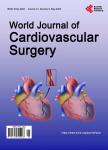Cardiovascular Function during First 24 Hours after Off-Pump and On-Pump CABG—A Prospective Observational Comparative Study
Cardiovascular Function during First 24 Hours after Off-Pump and On-Pump CABG—A Prospective Observational Comparative Study作者机构:Cardiothoracic & Vascular Surgery Nilratan Sircar Medical College & Hospital Kolkata India
出 版 物:《World Journal of Cardiovascular Surgery》 (心血管外科国际期刊(英文))
年 卷 期:2023年第13卷第4期
页 面:71-83页
学科分类:1002[医学-临床医学] 100210[医学-外科学(含:普外、骨外、泌尿外、胸心外、神外、整形、烧伤、野战外)] 10[医学]
主 题:Off-Pump CABG On-Pump CABG Cardiac Index Stroke Volume Left Ventricular Stroke Work Index Systemic Vascular Resistance Index
摘 要:Purpose: Myocardial revascularization by coronary artery bypass grafting (CABG) in ischemic heart disease patients has direct impact on hemodynamic parameters in the immediate post-operative period. The peri-operative cardiovascular functioning is an important determinant for outcome of surgery. In On-Pump CABG (ONCAB), the cardiopulmonary bypass has a negative effect on myocardium. Off-Pump CABG (OPCAB) avoids the effect of CPB but complete revascularization with difficult positioning of heart is technically demanding. This study is aimed to compare the cardiovascular functioning in the immediate post-operative period after OPCAB and ONCAB. Methods: Total 106 patients were operated for CABG from January 2015 to June 2016, of which 75 patients were operated for OPCAB and 31 patients were operated for ONCAB. For the comparison, hemodynamic parameters were measured during anesthesia before surgery, postoperatively after 1 and 4 hours (h) in the ICU, and in the morning after surgery, approximately after 20 h. Results: The time-dependent rise of hemodynamic parameters like Cardiac Output (CO), Cardiac Index (CI), Stroke volume (SV) and Left Ventricular Stroke Work Index (LVSWI) in the immediate post-operative hours (1 h and 4 h) are more predominant in OPCAB group than ONCAB group although the difference is eliminated mostly at 20 h. The better peripheral vasodilation after OPCAB causes immediate fall of Systemic Vascular Resistance Index (SVRI) after OPCAB. Conclusion: Better cardiovascular functioning immediately after OPCAB than ONCAB may be important for better hemodynamic stability. The difference is however eliminated after 24 hours indicating little significance in long term outcome.



